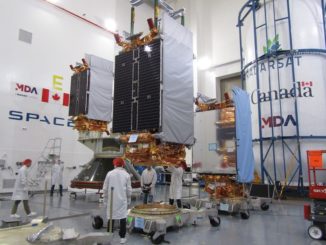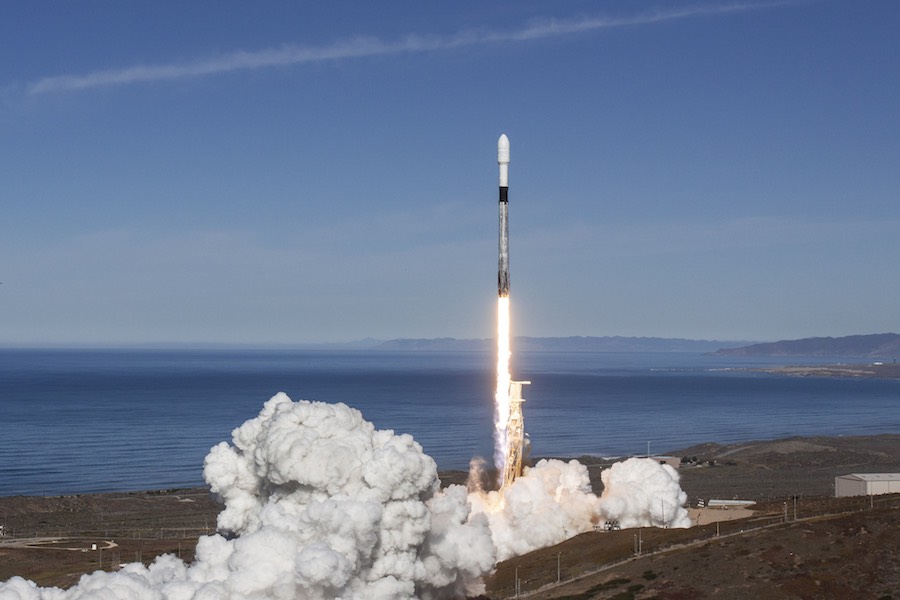
Setting new commercial launch and satellite industry records, a SpaceX Falcon 9 rocket propelled by a first stage booster launched and recovered two times before soared into a clear morning sky over California’s Central Coast on Monday with 64 small satellites, then returned to a pinpoint landing on a vessel parked offshore in the Pacific Ocean, potentially to be flown again.
The first stage of the Falcon 9 rocket launched Monday became the first commercial booster to accomplish three flights hauling satellites toward orbit, pushing SpaceX closer to its goal of re-flying boosters 10 times without maintenance or refurbishment between missions. Elon Musk, SpaceX’s billionaire founder and chief executive, considers that goal central to the company’s mission of reducing the cost of space transportation, enabling exploration — and ultimately settlements — on Mars.
Going into Monday’s launch, SpaceX had re-launched one of its Falcon 9 boosters 17 times, including a pair of modified first stages used on the inaugural flight of company’s Falcon Heavy rocket in February. But none of the boosters had launched more than twice before Monday’s re-flight of a first stage that debuted May 11 with a launch from the Kennedy Space Center in Florida, landed on a drone ship in the Atlantic Ocean, then lifted off again Aug. 7 from Cape Canaveral Air Force Station and touched down again on the drone ship.
SpaceX transported the rocket by road from Florida to Vandenberg Air Force Base, California, for final launch preps to blast off for.a third time.
The 229-foot-tall (70-meter), two-stage Falcon 9 rocket — its booster stage covered in soot and scorch marks from two fiery trips to the edge of space and back — ignited its nine Merlin main engines and lifted off from Vandenberg Air Force Base at 10:34:05 a.m. PST (1:34:05 p.m. EST; 1834:05 GMT) Monday.
The launcher tilted toward the south, riding 1.7 million pounds of thrust into a cloudless late autumn sky at the military-run spaceport around 140 miles (225 kilometers) northwest of Los Angeles.
The first stage shut down its engines less than two-and-a-half minutes into the mission after accelerating the rocket to a velocity of more than 3,600 mph (about 5,900 kilometers per hour), and pneumatic pushers separated the booster from the Falcon 9’s second stage, which SpaceX builds new for each mission.
While the upper stage’s single Merlin engine ignited for a roughly seven-and-a-half minute firing to place the mission’s payloads into orbit, the first stage fired a subset of its engines for boost-back and entry burns to aim the descending rocket for SpaceX’s drone ship “Just Read the Instructions” positioned around 30 miles (50 kilometers) off the coast of Vandenberg in the Pacific Ocean.
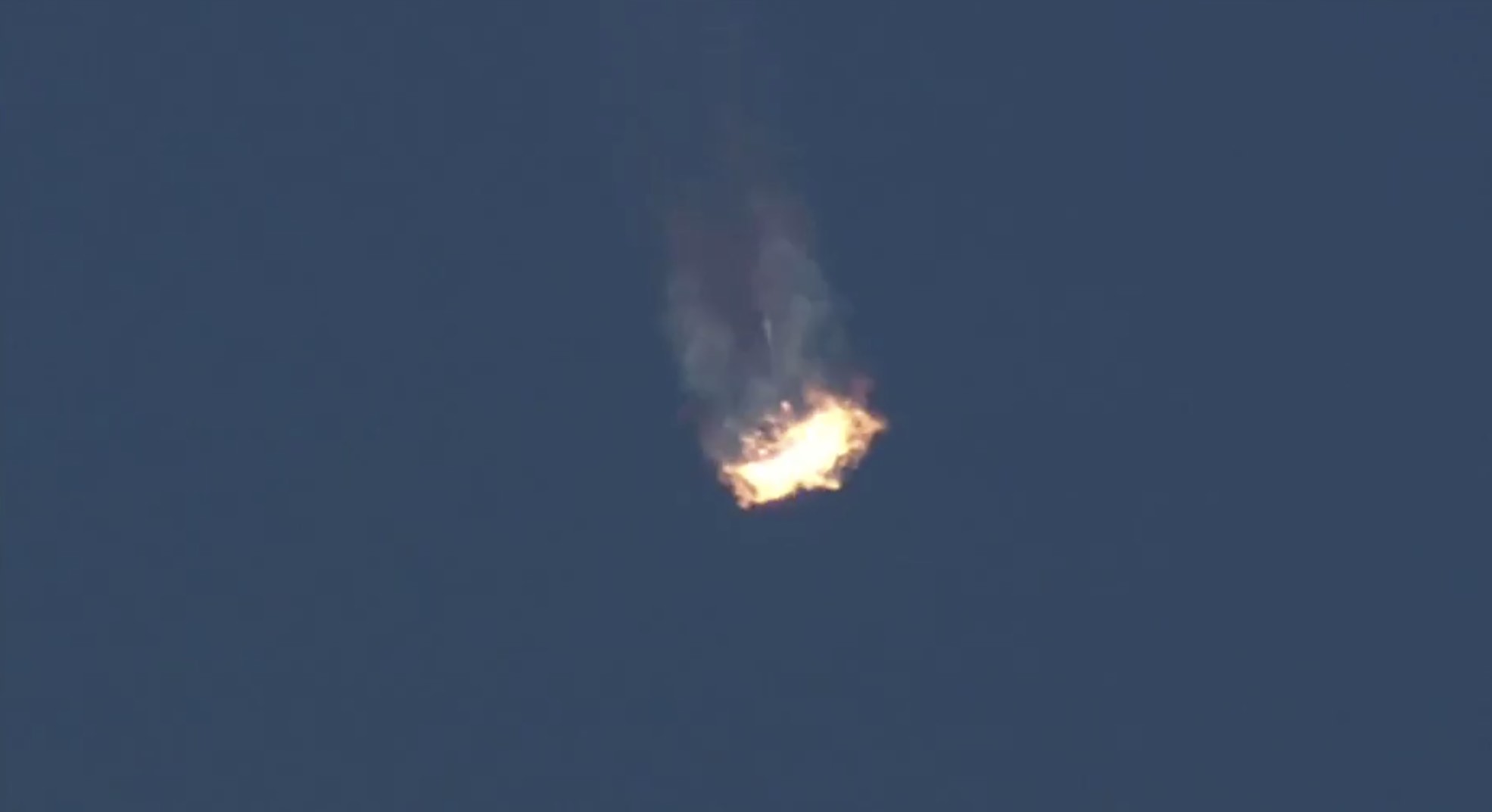
Long-range tracking cameras at Vandenberg captured spectacular views of the rocket coming back to Earth, then lighting its center engine and extending four landing legs before nailing a landing on the drone ship — all within view of spectators on the coast, thanks to an unusually clear morning at the military base.
SpaceX’s rocket landing drone ships are typically parked hundreds of miles offshore, but the company’s California-based rocket recovery vessel held position much closer to shore Monday.
Meanwhile, the Falcon 9’s second stage continued firing until T+plus 10 minutes to reach a targeted orbit around 357 miles (575 kilometers) above Earth, flying on a north-to-south path inclined 97.8 degrees to the equator.
During the second stage burn, the Falcon 9 jettisoned its clamshell-like nose shroud, which covered the mission’s 64 small satellite payloads during the first few minutes of the flight. After falling away from the rocket, the two halves of the fairing unfurled parafoils to slow their fall back to Earth, where a SpaceX-leased fast-moving boat named “Mr. Steven” tried to catch the shroud with a giant net.
The fairing catch attempt Monday was the first in more than four months by SpaceX, but Mr. Steven missed the fairing halves, despite the installation of a bigger net earlier this year, and several apparent practice runs in recent weeks using test hardware dropped from a helicopter.
Musk tweeted after Monday’s launch that the fairing halves will be retrieved from the sea, dried and used again.
Falcon fairing halves missed the net, but touched down softly in the water. Mr Steven is picking them up. Plan is to dry them out & launch again. Nothing wrong with a little swim.
— Elon Musk (@elonmusk) December 3, 2018
But it’s not clear how easy it will be to refurbish fairings after dropping into salt water. The method of catching the fairings using a net was intended to keep the shrouds away from the corrosive effects of sea water, a problem that lengthens the time needed for SpaceX to refurbish Dragon cargo capsules for reuse after splashing down in the ocean.
Earlier this year, Musk said the fairing costs around $6 million, representing about 10 percent of the total cost of a Falcon 9 launch. Approximately 60 percent of the marginal cost of a Falcon 9 launch comes from the first stage, 20 percent from the second stage, and around 10 percent from the processing, testing and assembly of a rocket for flight, according to Musk.
SpaceX has offered discounts from the Falcon 9’s advertised selling price of $62 million for customers willing to place their satellites on a reused rocket, or as SpaceX likes to say, a flight-proven booster. Musk said in May that SpaceX then charged around $50 million for flights using a previously-flown first stage, and he expected a “steady reduction in prices” as the company gains experience with reusing rockets, and as SpaceX pays off what Musk has said was a billion-dollar investment in the capability to recover and re-fly boosters.
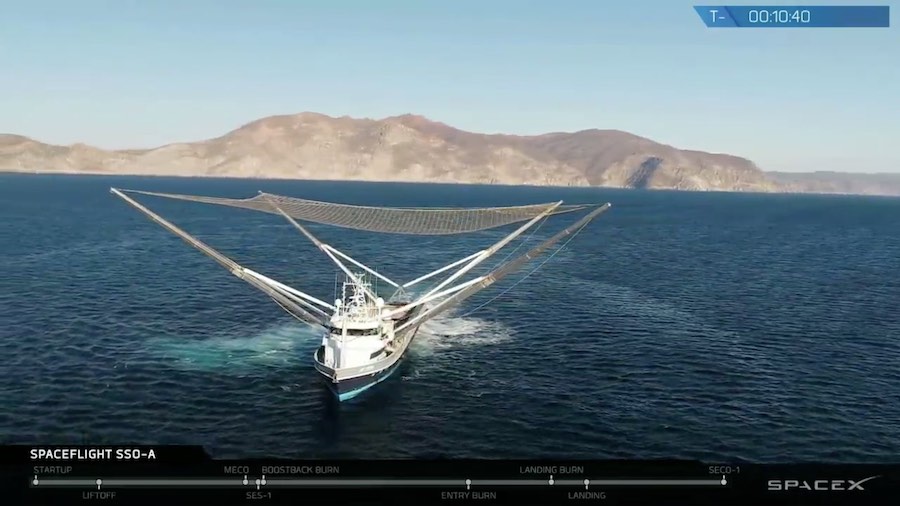
In May, Musk said Falcon 9 launches could cost as little as $5 million or $6 million per flight within around three years, assuming SpaceX can rapidly reuse first stage boosters, payload shrouds, and eventually Falcon 9 second stages. But after considering upgrades to beef up the Falcon 9 second stage for re-entry — it travels faster than the first stage, and would need to survive higher entry temperatures — Musk tweeted Nov. 16: “SpaceX is no longer planning to upgrade Falcon 9 second stage for reusability.”
After a few initial crash-landings, SpaceX’s recoveries of Falcon 9 first stages continue to produce results. More than half of SpaceX’s 19 launches this year have flown with reused boosters.
The new Block 5 version of the Falcon 9 rocket introduced in May includes changes to make the first stage easier to recover and reuse. But re-flying the boosters is still a learning process for SpaceX, said Hans Koenigsmann, SpaceX’s vice president of build and flight reliability
“One of the problems is fatigue,” he said in Oct. 3 remarks at the International Astronautical Congress in Bremen, Germany. “You’ve got to watch the life cycle on components. They vibrate, basically, and you’ve got to have an eye on fracture control and make sure that you don’t have any fractures on those components. That is actually not new. Helicopters do this right now. They are basically vibration machines, and they track, actually, the number of cycles, and they know exactly when they have to go into maintenance or preventive maintenance.
“Something similar is what we can do here on the rocket,” Koenigsmann continued. “We can basically record the flight load, and then log this to the history of the part, and we can figure out when the part has to be exchanged, if it actually has to be exchanged. Ideally, you do not want to change parts.”
Asked about how well the Block 5 boosters are holding up after each launch, Koenigsmann said: “I’m actually surprised. The launch of course, the engines see pretty hot exhaust gas to begin with, so putting the engines into the (re-entry) flow should be fine … I’m surprised how well the engines hold up. There are details. We receive damage, and we have made adjustments, I would say. That’s part of the reason why we have these blocks. We basically roll in changes to … improve the vehicle. At this point in time, I’m actually pretty happy.”
On missions launching satellites toward geostationary orbit, a perch more than 22,000 miles (nearly 36,000 kilometers) above Earth, the first stage can reach speeds of over 5,000 mph, subjecting it to hotter re-entry conditions on the way back to Earth. For payloads destined for low Earth orbit, a few hundred miles up, the first stage doesn’t need to travel as fast.
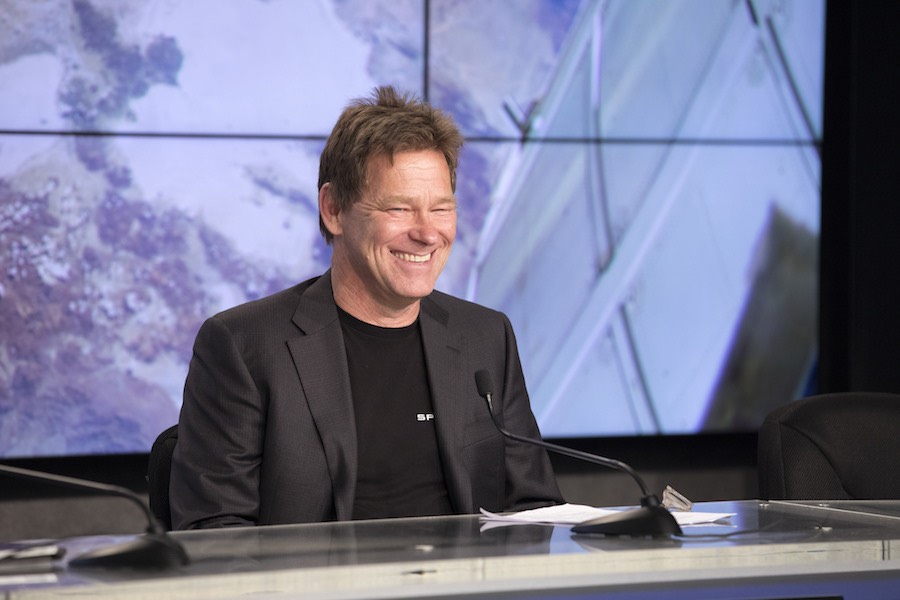
“There are some of the hotter re-entries, it’s still something we work on to perfect them and to make sure,” Koenigsmann said. “In the end, the goal is to take the rocket and move it over and launch again. We have the goal of launching, basically, within two days, and that would be tremendous if we do that.”
Speaking to reporters Monday at the Kennedy Space Center, Koenigsmann said he hopes SpaceX can re-fly the same rocket twice in 24 hours next year, a goal set by Musk earlier this year.
“It depends a little bit on how the missions work out,” Koenigsmann said Monday. “I hope we can do this next year … but it might slip a little bit. It’s certainly something we want to try as soon as we get the chance. It depends, basically, on which missions are ready.”
“The majority of work is the engine,” he said in October. “We refurbish the engine. Most of it actually is parts that are not qualified for the next flight, so we just swap the parts. It’s not actual damage. It’s a preventive maintenance kind of thing, where we know this part may fail the next time, so we just don’t take the risk and we swap it. We have some impact damage from stuff that flies out of the heat shield and hits the aero cover. That’s pretty much what it is. It’s actually not that bad.”
“The aero cover is the thing that basically is the raceway on the side,” he said. “We do look into the tanks to make sure there are no surprises in the tank, and so far we’ve found only clean tanks on the inside. We sometimes see damage from the thermal protection system impacting the aero covers, so they are reinforced to make sure we don’t break anything on landings.”
“In terms of refurbishment and building a new rocket, it’s way cheaper to refurbish,” Koenigsmann said.
“This didn’t happen overnight,” Koenigsmann said of the reusability effort. “We worked on this for many, many years, and we put a lot of money in there, and it was our own money that we put in there.”
SpaceX did have some financial help, not only from Musk’s fortune, but also from venture capital investments, and a cash infusion from Google. The company’s revenue-earning launch activity also generated money from commercial customers, plus NASA and the U.S. Air Force, which have billions of dollars in contracts with SpaceX. Much of that revenue was invested into research and development.
The next launch by SpaceX is scheduled for Wednesday from Cape Canaveral, where a Falcon 9 rocket is set for takeoff with a Dragon cargo craft heading for the International Space Station. The resupply launch will be SpaceX’s 20th mission of the year.
SpaceX, Spaceflight partner to deploy 64 satellites in orbit
An orbital ballet of sorts took over once the Falcon 9 rocket’s 10-minute powered flight sequence ended on Monday’s launch, involving the release of 64 small satellites, most of which were carried on two free-flying deployment buses designed and outfitted by Spaceflight, a company based near Seattle which specializes in securing launch bookings for small satellite operators.
Spaceflight has booked satellite launches on Antares, Dnepr, PSLV, Soyuz and Vega missions, but the company had never purchased the full capacity of a rocket until announcing plans for the “dedicated rideshare” mission, known as SSO-A: SmallSat Express, in 2015.
Most of the satellites on the SSO-A mission, which included 15 microsatellites and 49 CubeSats, were installed on two free flyers at Spaceflight’s facility in Auburn, Washington, officials said.
The deployment structure developed by Spaceflight consists of two hubs — an upper and a lower free flyer — carrying satellites and CubeSat dispensers. Both free flyers separated from the Falcon 9 rocket once it entered a polar, sun-synchronous orbit.
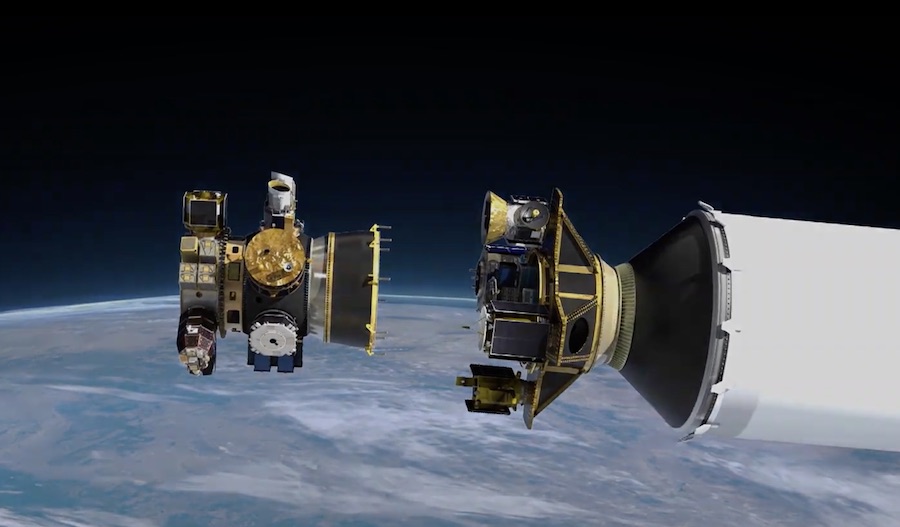
Curt Blake, president of Spaceflight, said the free flyers were based on Spaceflight’s Sherpa space tug, which the company intended to launch for the first time on a Falcon 9 flight shared with Taiwan’s Formosat 5 Earth observation satellite. But delays in Formosat 5’s launch, caused in part by a Falcon 9 rocket explosion on a launch pad in 2016, prompted Spaceflight to cancel the mission and find alternative launch opportunities for the smallsats reserved on the Sherpa flight.
The Formosat 5 mission finally launched in August 2017.
“Generically, we call it the Sherpa,” Blake said of the SSO-A mission in an interview with Spaceflight Now earlier this year. “But it is actually more than one hub. There’s an upper free flyer and and a lower free flyer. There’s a lot of spacecraft on each of those. It’s kind of a combination stack.”
A few of the larger passengers on the SSO-A mission were shipped directly to the Falcon 9 launch site at Vandenberg Air Force Base, where technicians mated them to the free flyers. In addition to the 60 payloads on the free flyers, four microsatellites were attached directly to the Falcon 9’s second stage, which commanded their separation after arriving in orbit.
The entire payload stack riding into orbit on the Falcon 9 rocket weighed around 4 metric tons — nearly 9,000 pounds — at the time of launch. Once in orbit around minutes after liftoff, the Sherpa modules, or free flyers, released from the rocket and begin separating the smallsats.
Both free flyers and the four microsatellites attached to the Falcon 9’s second stage were in orbit by the T+plus 43-minute point in the mission, but Spaceflight’s deployment module’s themselves continued on, using on-board batteries to power avionics and issue commands to release the separate the 60 spacecraft.
The exact sequence of the satellite separation maneuvers was considered proprietary by Spaceflight, but mission managers said each deployment was timed approximately every five-to-six minutes, with the final payload set for separation around 4 hours, 45 minutes, after liftoff — approximately 3:19 p.m. PST (6:19 p.m. EST; 2319 GMT).
It was then expected to take another hour or so for Spaceflight to confirm all the satellites have separated, once the free flyers pass over a ground station to enable communications. There were no on-board cameras on either free flyer, according to Spaceflight.
“We’ve developed a deployment sequence that’s based off a high-fidelity analysis that we did specifically to make sure our customers don’t collide into each other upon deployment, so we’re taking our time,” said Jeff Roberts, Spaceflight’s SSO-A mission manager, said in an interview with Spaceflight Now. “We make sure that we phase that to maximize the distance in separation between all of our customers.”
That should help the U.S. military, which tracks objects in orbit, more quickly identify the satellites released on the SSO-A mission, an issue that has caused headaches in the past.
The free flyers were designed to operate as independent spacecraft themselves, with their own computers, electronics and batteries.
“We refer to them as free flyers because that’s exactly what they are. There is no propulsion system on-board. They just simply hold all the avionics and the dispensers to command deployment,” Roberts said.
The upper free flyer is based on a commonly-used secondary payload adapter — known as an ESPA ring — built by Moog. The lower free flyer is Spaceflight’s own design, according to Roberts.
The free flyer modules, which had a 16-hour battery life, will unfurl drag sails after the satellite deployments to help bring the dispensers back into Earth’s atmosphere.
Spaceflight has not publicly released an accounting of all 64 payloads aboard the SSO-A rideshare mission, citing non-disclosure agreements signed with the company’s customers. But Roberts said the company provided a list to the Federal Communications Commission to obtain launch licenses for the mission, and Spaceflight submitted the separation sequence, information on spacecraft sizes, and points-of-contact for each payload to the U.S. military’s Combined Space Operations Center, which is charged with cataloguing, tracking and identifying all objects launched into orbit.
Roberts said some concerns about the mission are unfounded, such as worries about the difficulty of tracking the smallsats launched on the SSO-A mission to ensure they don’t create a space debris hazard. “Our engineering team has put a ton of effort into every aspect of this mission,” he said.
Some customers have disclosed their payloads were on the SSO-A launch.
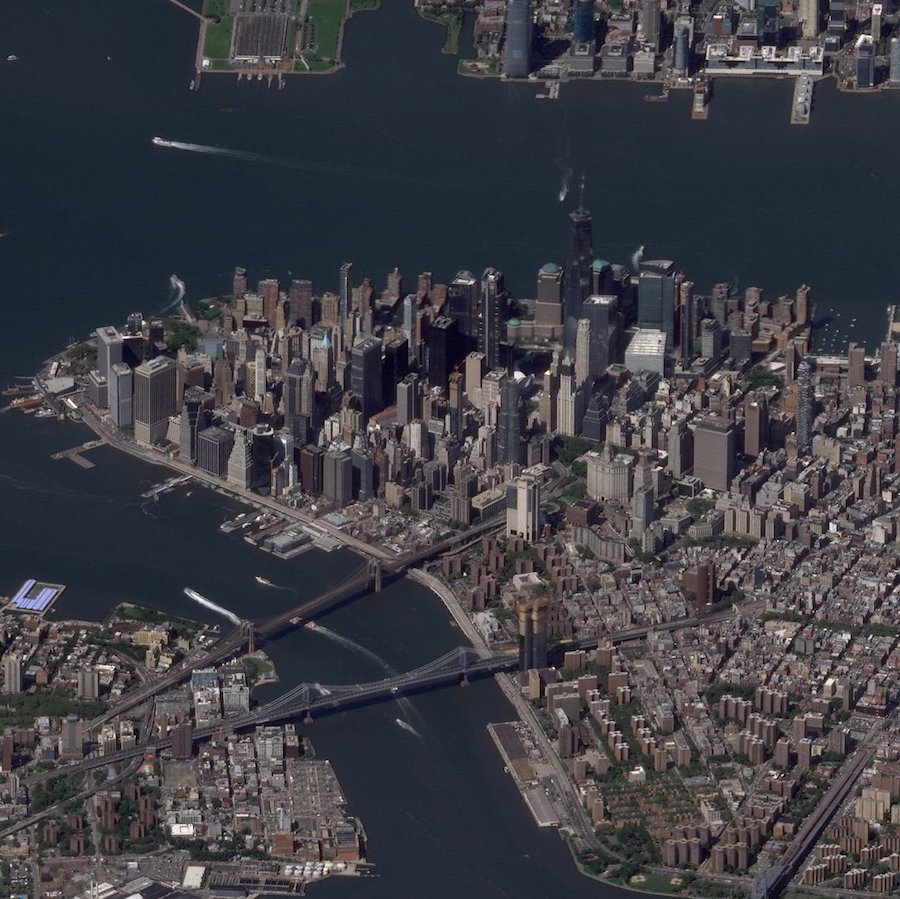
Planet was one of major commercial customers on the mission. Two of its SkySat microsatellites and three Dove CubeSats — debuting new camera and telescope designs — joined its large fleet of Earth-imaging craft in orbit, which now numbers 137 active satellites. Planet also sponsored the launch of two CubeSats from the Georgia Institute of Technology and the University of Colorado in Boulder’s Laboratory for Atmospheric and Space Physics.
Three missions funded by the U.S. military were among the largest spacecraft on the SSO-A mission. They are STPSat 5, a microsatellite from the Air Force’s Space Test Program which hosts five experiments, the eXCITe spacecraft funded by the Defense Advanced Research Projects Agency — DARPA — and the FalconSat 6 satellite built by students at the Air Force Academy.
There was also a microsatellite from DLR, the German Aerospace Center, named Eu:CROPIS, which carries tomato seeds to monitor how they germinate and grow in reduced gravity. The spacecraft will slowly spin during its mission, simulating gravity conditions on the moon and Mars.
Spaceflight announced in a press release Monday evening that all 64 microsatellites and CubeSats successfully separated in orbit. Many of the satellite owners announced they acquired signals or beacons from their spacecraft, confirming their status following Monday’s ride into orbit on top of a SpaceX Falcon 9 rocket.
“This was an incredibly complex mission, and I’m extremely proud of what our talented team at Spaceflight has achieved,” Blake said in a post-launch statement. “SSO-A is a major milestone for Spaceflight and the industry. We’ve always been committed to making space more accessible through rideshare. This mission enabled 34 organizations from 17 different countries to place spacecraft on orbit. It’s also special because it was completely dedicated to smallsats.”
The mission set a record for the highest number of satellites ever to launch on a U.S. rocket, but it fell short of the global mark of 104 satellites, which flew on a single Indian rocket last year.
Two managers involved with additional payloads aboard the SSO-A mission — SeaHawk 1 and Capella 1 — offered their thoughts after the successful launch.
“We are thrilled to have SeaHawk-1 on orbit and to be part of such a historic launch superbly executed by Spaceflight,” said John Morrison, SeaHawk’s co-project manager and lead principal investigator at the University of North Carolina Wilmington. “SeaHawk will make ocean observations at significantly higher spatial resolution and at much lower costs than standard satellite systems. Since the data collected will be publicly available, our hope is that it will benefit not only researchers, but policymakers and others to make informed decisions when addressing issues related to the environment.”
“This launch was an impressive undertaking and an important milestone for the smallsat industry as well as for many of the organizations involved,” said Payam Banazadeh, founder and CEO of Capella Space Corporation. “Capella’s first satellite is now on orbit and we are one step closer to our goal of providing timely, reliable, and frequent information using synthetic aperture radar technology.”
The British smallsat manufacturer SSTL confirmed the 231-pound (105-kilogram) KazSTSAT Earth-imaging satellite contacted ground controllers to confirm its health. KazSTSAT was one of the biggest payloads launched today, and it’s owned by Ghalam LLC, a joint venture between JSC “National Company Kazakhstan Garysh Sapary” (KGS) and Airbus Defense and Space.
The ICEYE X2 radar imaging satellite, the second spacecraft launched by the Finnish company ICEYE, was also broadcasting telemetry after its deployment Monday. ICEYE says it has eight more spacecraft due for launch by the end of 2019, as the company seeks to build out the world’s largest constellation of synthetic aperture radar satellites. Earlier this year, the company became the first to send a satellite with a mass less than 100 kilograms — about 220 pounds — into orbit with a radar imager, a type of all-weather Earth-observing instrument previously relegated to heavier, more power-hungry, and more expensive spacecraft.
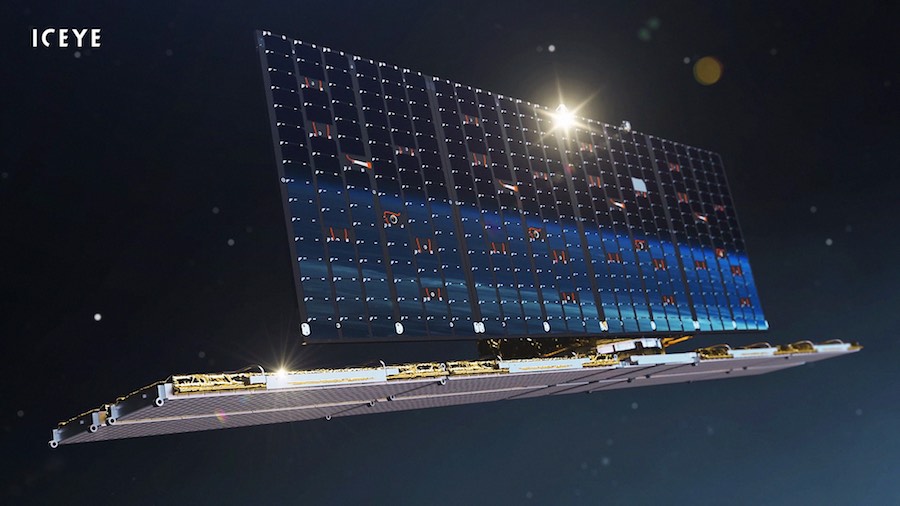
One of the CubeSats on the Falcon 9 launch — Elysium Star 2 — carries cremated human remains, and another was conceived as an art project and sponsored by the Los Angeles County Museum of Art to honor Robert Lawrence, an African American astronaut was selected for the U.S. Air Force’s Manned Orbiting Laboratory program. A bust of Lawrence, who died in 1967 before he flew in space, is on the Enoch CubeSat.
“To honor the astronaut’s legacy, (Tavares) Strachan created a 24-karat gold canopic jar with a bust of Lawrence,” the Los Angeles County Museum of Art wrote on a page deviated to the mission. “The canopic jar nods to a practice employed by the ancient Egyptians to protect and preserve organs of the deceased for use in the afterlife. The canopic jar was blessed at a Shinto shrine in Fukuoka, Japan, and was recognized as a container for Lawrence’s soul.”
Spaceflight considers future rideshare plans after SSO-A’s ‘complex undertaking’
Blake told Spaceflight Now the SSO-A mission turned out to be a complex undertaking.
“To fill, or to make profitable buying a rocket the size of Falcon 9, you have to aggregate a lot of small spacecraft,” he said. “Just understanding what kind of timescale that’s going to take and how many satellites you’re going to have to aggregate to hit that one point in time — that’s one lesson — just understanding where that is, and how difficult it is.
“The second one is during the timeframe as you’re getting ready, different customers have different potential issues,” he added. “Some float through as easy as can be. Others may have difficulties along the way. We’ve had to move different customers around on the stack. That means that you really need to have an ability to configure and reconfigure the stack, (and) the electronics that go into the deployments.”
Seven CubeSats dropped off the SSO-A mission since August because they were not ready for launch, or had difficulty obtaining regulatory approval.
The record number of satellites launched on a single rocket is 104, set by an Indian PSLV mission last year. Some of those payloads were customers of Spaceflight, but not all. The SSO-A mission will set a record for the most satellites aboard a U.S. launcher.
Blake said Spaceflight has no immediate plans to buy another dedicated Falcon 9 launch. The economical and logistical sweet spot for rideshares may be using a smaller rocket, he said.
“We’re making sure to see how this one goes, and getting all the lessons learned out of it, before turning our attention to doing another one this large,” Blake said. “Having said that, we’re actively looking at different ones on medium-sized launch vehicles.
The company has agreements for future smallsat rideshare launches on Arianespace’s Vega rocket, Rocket Lab’s Electron, and Virgin Orbit’s air-dropped LauncherOne vehicle — all significantly smaller, and less expensive, than a Falcon 9, which currently sells for around $50 million to $60 million per flight.
“We know about aggregating a number of payloads onto small launch vehicles,” Blake said. “You can think of those as dedicated missions as well, where we’ve got five or 10 different spacecraft on a smaller launch vehicle, 30 or 40 on a medium-sized launch vehicle. The thing we’ll take time to sort out is how it goes on a large launch vehicle like this.”
Here’s a list of most of the payloads on the SSO-A mission, based on the best public information available.
- Audacy Zero – Audacy – USA
- BlackHawk – ViaSat – USA
- BRIO – SpaceQuest- USA
- THEA – SpaceQuest – USA
- Capella 1 – Capella Space – USA
- Landmapper BC-4 – Astro Digital – USA
- CSIM-FD – LASP/University of Colorado – USA
- Flock 3s Doves (3 spacecraft) – Planet – USA
- SkySat 14, 15 (2 spacecraft) – Planet – USA
- Elysium Star 2 – Elysium Space – USA
- Enoch – Los Angeles County Museum of Art – USA
- eXCITe/SeeMe – Novawurks & DARPA – USA
- FalconSat 6 – U.S. Air Force Academy – USA
- Fox 1C – AMSAT – USA
- BlackSky Global 2 – BlackSky Global – USA
- Hawk A, B, C (3 spacecraft) – HawkEye 360 – USA
- ICE-Cap – U.S. Navy – USA
- IRVINE02 – Irvine CubeSat STEM Program – USA
- MinXSS 2 – LASP/University of Colorado – USA
- ORS 7A, 7B Polar Scouts – Operationally Responsive Space, Dept. of Defense, Dept. of Homeland Security – USA
- Orbital Reflector – OR Productions & Nevada Museum of Art – USA
- RANGE A, B (2 spacecraft) – Georgia Tech – USA
- SeaHawk 1 – University of North Carolina at Wilmington – USA
- SpaceBEE 5, 6, 7 (3 spacecraft) – Swarm Technologies – USA
- STPSat 5 – U.S. Air Force Space Test Program – USA
- WeissSat 1 – Weiss School – USA
- Centauri II – Fleet Space Technologies – Australia
- RAAF M1 – University of New South Wales – Australia
- SIRION Pathfinder 2 – Sirion Global – Australia
- ITASAT – Instituto Tecnológico de Aeronáutica – Brazil
- ICEYE X2 – ICEYE – Finland
- Suomi 100 – Aalto University Science and Technology – Finland
- Eu:CROPIS – DLR, German Aerospace Center – Germany
- MOVE-II – Technische Universität München – Germany
- ExseedSat-1 – Exseed Space – India
- Eaglet-1 – OHB Italia S.p.A./Italian Ministry of Defense – Italy
- ESEO – ESA & SITAEL – Italy
- JY1-Sat – Crown Prince Foundation – Jordan
- KazSciSat-1 – Ghalam LLP – Kazakhstan
- KazSTSAT – Ghalam LLP – Kazakhstan
- Hiber 2 – Hiber/Innovative Solutions in Space – Netherlands
- PW-Sat 2 – Warsaw University of Technology – Poland
- K2SAT – Korean Air Force Academy – South Korea
- NEXTSat-1 – Korea Advanced Institute of Science and Technology – South Korea
- SNUGLITE – Seoul National University – South Korea
- SNUSAT-2 – Seoul National University – South Korea
- VisionCube – Korea Aerospace University – South Korea
- AISTECHSAT 2 – Aistech – Spain
- Astrocast 0.1 – Astrocast – Switzerland
- KNACKSAT – King Mongkut’s University of Technology North Bangkok – Thailand
- VESTA – Honeywell Aerospace/SSTL/exactEarth Ltd. – UK/Canada
Email the author.
Follow Stephen Clark on Twitter: @StephenClark1.


